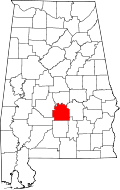Braggs, Alabama | |
|---|---|
| Coordinates: 32°03′02″N86°47′44″W / 32.05056°N 86.79556°W | |
| Country | United States |
| State | Alabama |
| County | Lowndes |
| Elevation | 285 ft (87 m) |
| Time zone | UTC-6 (Central (CST)) |
| • Summer (DST) | UTC-5 (CDT) |
| Area code | 334 |
Braggs is an unincorporated community in Lowndes County, Alabama, United States. [1]


